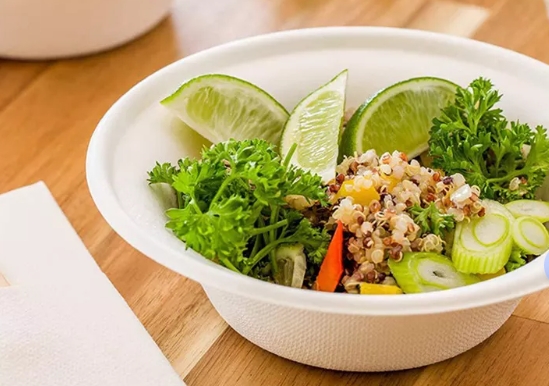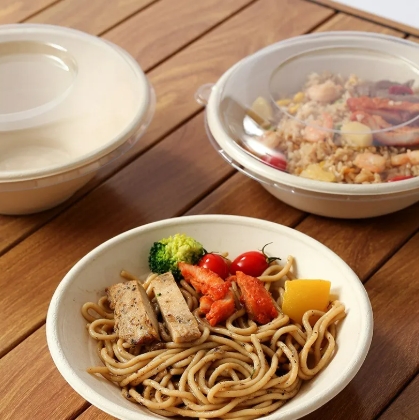
Content Menu
● What is Sugarcane Pulp Packaging?
● Environmental Benefits of Sugarcane Pulp Bowl and Lid
>> Renewable Resource Utilization
>> Biodegradability and Compostability
>> Reduction of Carbon Footprint
>> Waste Valorization
● Practical Advantages of Sugarcane Pulp Bowl and Lid
>> Strength and Durability
>> Food Safety and Hygiene
>> Versatility in Design
>> Microwave and Freezer Safe
● Economic and Social Impacts
>> Supporting Local Agriculture
>> Job Creation
>> Enhancing Brand Reputation
● Sugarcane Pulp Bowl and Lid vs. Traditional Packaging
● How Sugarcane Pulp Packaging Contributes to a Sustainable Future
>> Reducing Plastic Pollution
>> Promoting Circular Economy
>> Meeting Regulatory Requirements
● Applications of Sugarcane Pulp Bowl and Lid
>> Food Service Industry
>> Retail and Grocery
>> Events and Catering
>> Household Use
● Challenges and Considerations
>> Cost Implications
>> Infrastructure for Composting
>> Consumer Awareness
● Future Trends in Sustainable Packaging
>> Innovation in Materials
>> Policy and Regulation
>> Consumer Demand
● Conclusion
● Frequently Asked Questions (FAQ)
>> 1. What makes sugarcane pulp bowls and lids eco-friendly?
>> 2. Are sugarcane pulp bowls and lids safe for all types of food?
>> 3. Can sugarcane pulp bowls and lids be used in the microwave and freezer?
>> 4. How should sugarcane pulp packaging be disposed of after use?
>> 5. Are there any limitations to using sugarcane pulp bowls and lids?
Sustainable packaging is no longer a niche trend; it is a global movement reshaping how businesses operate and how consumers make choices. With environmental concerns escalating and the demand for eco-friendly products on the rise, companies are seeking alternatives to traditional plastics and non-renewable materials. Among these alternatives, sugarcane pulp bowls and lids have gained notable attention for their impressive combination of functionality, sustainability, and versatility. This article explores the multifaceted benefits of using sugarcane pulp bowl and lid for sustainable packaging, highlighting their environmental, economic, and practical advantages, and examining how they are shaping the future of responsible packaging.

What is Sugarcane Pulp Packaging?
Sugarcane pulp packaging is crafted from bagasse, the fibrous residue left after extracting juice from sugarcane stalks. Traditionally considered agricultural waste, bagasse is now transformed into a valuable resource. Through a process of cleaning, pulping, and molding, manufacturers create sturdy, compostable, and biodegradable packaging products. Bowls and lids made from sugarcane pulp are particularly popular in the food service industry, offering an eco-friendly alternative to single-use plastics and foam containers.
Environmental Benefits of Sugarcane Pulp Bowl and Lid
Renewable Resource Utilization
Sugarcane is a rapidly renewable crop, cultivated in many regions across the globe. By utilizing bagasse, a byproduct of sugar production, manufacturers reduce dependency on finite resources like petroleum. This not only lessens the environmental impact but also supports a more circular economy where waste from one process becomes the raw material for another.
Biodegradability and Compostability
Unlike conventional plastic packaging, sugarcane pulp bowls and lids are fully biodegradable and compostable. When disposed of properly, they break down naturally within a few months, returning nutrients to the soil and leaving no toxic residues behind. This characteristic significantly reduces the burden on landfills and helps combat the growing problem of plastic pollution.
Reduction of Carbon Footprint
The production of sugarcane pulp packaging requires less energy compared to petroleum-based plastics. Additionally, sugarcane plants absorb carbon dioxide during their growth, helping to offset emissions generated during manufacturing. This results in a packaging solution with a lower overall carbon footprint, supporting efforts to mitigate climate change.
Waste Valorization
Transforming bagasse from agricultural waste into a valuable packaging material exemplifies waste valorization. This approach diverts waste from landfills or incineration, reduces environmental pollution, and adds economic value to the sugarcane industry. It also creates new revenue streams for farmers and processors, supporting local economies.
Practical Advantages of Sugarcane Pulp Bowl and Lid
Strength and Durability
Sugarcane pulp bowls and lids are engineered to be strong and durable. They can withstand both hot and cold temperatures, making them suitable for a wide range of foods, including soups, salads, and desserts. Their sturdy construction ensures they do not easily deform, leak, or collapse, providing a reliable option for both dine-in and takeaway services.
Food Safety and Hygiene
These packaging products are manufactured to meet strict food safety standards. They are free from harmful chemicals and additives, making them safe for direct contact with food. The smooth surface and tight-fitting lids help maintain food hygiene by preventing contamination and spillage during transport.
Versatility in Design
Sugarcane pulp packaging can be molded into various shapes and sizes, allowing for extensive customization. Bowls and lids can be tailored with branding elements such as logos, colors, and product information, enhancing the customer experience and reinforcing brand identity.
Microwave and Freezer Safe
Sugarcane pulp bowls and lids are compatible with both microwave and freezer use. Consumers can conveniently reheat or store food without transferring it to another container, adding to the practicality and appeal of these products for modern lifestyles.
Economic and Social Impacts
Supporting Local Agriculture
The adoption of sugarcane pulp packaging creates demand for bagasse, supporting local agriculture and providing additional income for sugarcane farmers. This can stimulate rural economies and encourage sustainable farming practices.
Job Creation
The manufacturing process for sugarcane pulp products involves several stages, from collecting and processing bagasse to molding and distribution. This industry generates employment opportunities across the supply chain, supporting communities and fostering economic development.
Enhancing Brand Reputation
Businesses that adopt sustainable packaging solutions like sugarcane pulp bowls and lids can enhance their reputation among environmentally conscious consumers. Demonstrating a commitment to sustainability can differentiate brands in a competitive market, attract new customers, and foster loyalty among existing ones.

Sugarcane Pulp Bowl and Lid vs. Traditional Packaging
| Feature | Sugarcane Pulp Bowl & Lid | Plastic Packaging | Paper Packaging |
| Renewable Resource | Yes | No | Yes |
| Biodegradable | Yes | No | Sometimes |
| Compostable | Yes | No | Sometimes |
| Food Safety | High | Varies | Varies |
| Strength & Durability | High | High | Medium |
| Microwave Safe | Yes | Sometimes | Sometimes |
| Freezer Safe | Yes | Sometimes | Sometimes |
| Customization | High | High | High |
| Environmental Impact | Low | High | Medium |
How Sugarcane Pulp Packaging Contributes to a Sustainable Future
Reducing Plastic Pollution
Single-use plastics are a major source of environmental pollution, harming wildlife and contaminating natural ecosystems. Sugarcane pulp bowls and lids provide a sustainable alternative, reducing the demand for plastic and helping to keep our planet cleaner.
Promoting Circular Economy
Sugarcane pulp packaging embodies the principles of a circular economy by utilizing agricultural byproducts and designing products for compostability. This approach encourages resource efficiency, reduces waste, and supports the regeneration of natural systems.
Meeting Regulatory Requirements
Many regions are implementing stricter regulations on single-use plastics and encouraging the use of sustainable materials. Sugarcane pulp bowls and lids help businesses comply with these regulations, avoiding penalties and demonstrating environmental stewardship.
Applications of Sugarcane Pulp Bowl and Lid
Food Service Industry
Restaurants, cafes, and catering services are primary users of sugarcane pulp bowls and lids. These products are ideal for serving a variety of dishes, from hot soups to cold salads, and are suitable for both dine-in and takeaway orders.
Retail and Grocery
Grocery stores and food retailers use sugarcane pulp packaging for pre-packaged meals, fresh produce, and deli items. The packaging's durability and food safety features make it a preferred choice for ready-to-eat products.
Events and Catering
Large-scale events, such as festivals and corporate gatherings, benefit from the use of compostable sugarcane pulp bowls and lids. These products simplify waste management and support event organizers' sustainability goals.
Household Use
Consumers are increasingly choosing sugarcane pulp bowls and lids for home use, particularly for parties, picnics, and meal preparation. Their convenience and eco-friendly attributes make them an attractive alternative to traditional disposable containers.
Challenges and Considerations
Cost Implications
While sugarcane pulp packaging offers numerous benefits, it can be more expensive than conventional plastic options. However, as demand increases and production scales up, costs are expected to decrease, making these products more accessible to businesses of all sizes.
Infrastructure for Composting
The effectiveness of sugarcane pulp packaging's compostability depends on the availability of composting facilities. In regions lacking such infrastructure, these products may not break down as intended, highlighting the need for investment in waste management systems.
Consumer Awareness
Educating consumers about the benefits and proper disposal of sugarcane pulp packaging is essential for maximizing its environmental impact. Clear labeling and public awareness campaigns can help ensure that these products are composted rather than sent to landfill.
Future Trends in Sustainable Packaging
Innovation in Materials
Research and development in sustainable materials continue to drive innovation in packaging. Advances in sugarcane pulp processing and the integration of other plant-based fibers may further enhance the performance and sustainability of these products.
Policy and Regulation
Governments worldwide are introducing policies to phase out single-use plastics and promote sustainable alternatives. This regulatory landscape is expected to accelerate the adoption of sugarcane pulp packaging across various industries.
Consumer Demand
As consumers become more environmentally conscious, demand for sustainable packaging solutions will continue to grow. Businesses that proactively adopt sugarcane pulp bowls and lids position themselves to meet evolving consumer expectations and regulatory requirements.
Conclusion
Sugarcane pulp bowls and lids represent a significant advancement in sustainable packaging. Their environmental benefits, practical advantages, and positive economic and social impacts make them an ideal choice for businesses and consumers seeking to reduce their ecological footprint. As innovation and awareness continue to grow, sugarcane pulp packaging is poised to play a pivotal role in shaping a more sustainable future for the packaging industry.

Frequently Asked Questions (FAQ)
1. What makes sugarcane pulp bowls and lids eco-friendly?
Sugarcane pulp bowls and lids are made from bagasse, a renewable byproduct of sugarcane processing. They are fully biodegradable and compostable, breaking down naturally without leaving harmful residues. This makes them an environmentally responsible alternative to traditional plastic packaging.
2. Are sugarcane pulp bowls and lids safe for all types of food?
Yes, these products are designed to meet food safety standards and are suitable for both hot and cold foods. They do not contain harmful chemicals and are safe for direct contact with a wide variety of dishes.
3. Can sugarcane pulp bowls and lids be used in the microwave and freezer?
Sugarcane pulp bowls and lids are microwave and freezer safe. They can withstand high temperatures without deforming and are suitable for storing food in cold environments, making them versatile for various uses.
4. How should sugarcane pulp packaging be disposed of after use?
After use, sugarcane pulp packaging should be placed in a composting facility where it will break down naturally. If composting is not available, it can be disposed of with organic waste, but composting is recommended for maximum environmental benefit.
5. Are there any limitations to using sugarcane pulp bowls and lids?
While sugarcane pulp bowls and lids offer many benefits, they may be more expensive than traditional plastics and require proper composting facilities for optimal disposal. Consumer education and infrastructure development are key to overcoming these challenges.

















